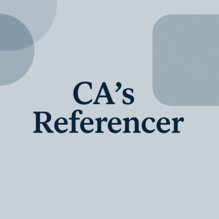Chartered Accountants caution joint bank account holders about this critical issue with tax rules that can lead to tax notices
Aug 21, 2025
Synopsis
Chartered Accountants highlight a critical issue with tax rules. Rule 114E(2) causes duplicate reporting for joint account holders. This leads to unnecessary tax notices, especially for non-filers. Experts suggest reviewing AIS/TIS and reporting income correctly. Taxpayers should maintain records of investments. The current system needs a fix to avoid penalizing joint holders, particularly senior citizens.
O.P. Yadav, Tax Evangelist at Prosperr.io & former Principal Commissioner of Income Tax Department, along with others have highlighted a critical issue regarding the implementation of Rule 114E(2) for joint bank account holders.
In summary, Rule 114E(2) of the Income Tax Rules stipulates that banks and other financial institutions are required to report high-value transactions exceeding a specific threshold to the tax department through Specified Financial Transaction (SFT) filings. The issue arises from the fact that banks are reporting these transactions twice for joint account holders.
Yadav said on Linkedin:
“A critical issue has emerged in the interpretation and implementation of Rule 114E(2), particularly in cases of joint accounts and investments, where the entire value of a transaction for reporting purposes under Specified Financial Transaction (SFT) is attributed to all account holders, regardless of who made the investment or deposit.”
“Under Rule 114E(2), when such transactions are held jointly, the full value is required to be attributed to all persons named on the account by the reporting entity. As a result, if a deposit of Rs 10 lakh is made in a joint account (say, by the primary holder), Rs 10 lakh is reflected in the Annual Information Statement (AIS) of both holders—irrespective of who actually made the investment.”
“Despite submitting feedback on AIS clarifying that they did not make the transaction, their responses are rejected by the reporting entity, citing Rule 114E(2). Consequently, these individuals are receiving notices under Section 148A (reassessment) or Section 133(6) (e-verification) of the Income Tax Act, 1961.”
ET Wealth Online reached out to various legal and tax experts about this. Here’s what they said:
Chartered Accountant Abhishek Soni, co-founder, Tax2Win, says: “Yes, O.P. Yadav is right in highlighting concerns with Rule 114E(2). As per this rule, reporting entities (like banks and mutual funds) must report the entire value of a transaction under the PAN of all joint holders, regardless of who actually invested.
This often leads to:
Duplicate entries in AIS
Mismatch in financial profiles
Unnecessary tax notices, especially for non-filers or low-income joint holders like homemakers.”
S. Sriram, Executive Partner at Lakshmikumaran & Sridharan Attorneys said : “In the absence of clarity from the Income Tax Department (Revenue Authority) on reporting requirements, Financial Institutions would always follow a conservative approach and report the transaction in the name of both the joint holders. When accounts/ deposits are held under a joint name, the question of the person responsible for paying tax on the interest arising therein is very fact specific.”
Sriram explains: “The Revenue Authorities will have to examine facts of each case to tax the owner of the income. The fact-finding exercise would be tedious for both the taxpayer and administrator. Through a self-declaration from one of the account holders can be a starting point for the examination, the Revenue Authorities cannot practically act on such declaration alone. However, they can in no case treat the income as being attributable to the person who has not made the deposits.”
If this issue is not fixed then individual taxpayers can get tax notice
According to Yadav, “Unfortunately, the implementation of the rule is increasingly resulting in tax notices being sent to elderly individuals — often the non-contributing, second holder in a joint account — most commonly the spouse of the actual investor.”
Sriram says there is no solution yet for this issue. He says:“Unfortunately, the current Income Tax Return (ITR) forms do not provide for any mechanism to avoid such situations. A separate scheme for mapping such joint accounts and identifying the real owner of the income would have to be brought in to avoid such situations. Such a system exists today, though in an elementary manner, for tracing TDS deducted in the name of one person, but income being offered by another. Such a system would have to be developed in a robust manner for joint asset owners, to overcome this problem.”
Soni says though the rule is technically correct, but its implementation does not reflect true ownership, creating compliance challenges.
Can this happen with any taxpayer irrespective of age?
Soni says this issue is common for all taxpayers and can affect taxpayers below 60 years of age as well.
Soni says: “Under Rule 114E(2), when high-value financial transactions (like mutual fund purchases or bank deposits) are held jointly, the entire amount is reported against all joint holders, regardless of who actually made the investment. So, even a young or low-income individual may see such transactions in their AIS, which could trigger automated tax notices or verification queries. Age is not a factor—this rule applies to all joint holders, irrespective of income or age.”
What should taxpayers with joint accounts do while filing ITR to prevent this kind of situation?
Soni explains what joint bank or investment account holders should do while filing ITR:
Review AIS/TIS: Check for any incorrect entries linked to joint holdings.
Give correct feedback: If the investment doesn’t belong to you, mark it in AIS as “Information relates to other PAN.”
Report income correctly: Only the person who funded the investment should report related income (capital gains/dividends).
Consider voluntary filing: If you're a joint holder with no taxable income but high-value transactions appear in AIS, file ITR voluntarily to avoid future notices.
Keep Records: Maintain proof of who made the investment to support your claim if queried.
Rule Rule 114E(2) and its ripple effects on taxpayers
Yadav explains that as per Rule 114E of the Income Tax Rules, financial institutions such as banks, co-operative banks, post offices, mutual funds, and companies issuing bonds or debentures are required to report high-value financial transactions exceeding Rs 10 lakh in a financial year.
Yadav says: “This threshold applies uniformly across several categories, including Cash deposits in savings or fixed deposit accounts (excluding current accounts); Investments in bonds or debentures and Purchases of mutual fund units.”
Yadav explains the ground reality of this issue:
Senior citizens and retired individuals often add their spouse or children as secondary holders for convenience, but the transactions entered by such Senior citizens and retired individuals are also reported in the case of secondary holders.
What is especially troubling is that in a vast majority of joint accounts, the second holder is the senior citizen spouse, included simply for ease of access, family convenience, or succession planning. These spouses often have no independent source of income, and in most cases, did not contribute to the deposit or investment.
However, under Rule 114E(2), the entire value of the transaction is attributed to both holders, without regard for who actually made the financial contribution. This leads to both the primary and the non-contributing joint holder receiving alerts under e-campaign and, in many cases, notices under Section 148A or 133(6).
Yadav says that the current implementation of Rule 114E, though precise in logic, fails in practice when it comes to joint accounts and innocent co-holders. Yadav says: “Senior citizens deserve a system that protects them, not penalizes them for simply being listed as joint holders. It is time for policymakers to acknowledge the unintended pain points and bring a senior-friendly fix to Rule 114E—one that preserves the integrity of the SFT framework while protecting the dignity of our elders.”
[The Economic Times]


